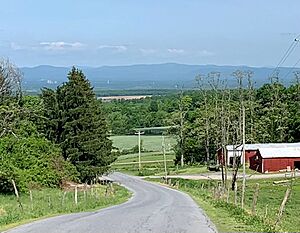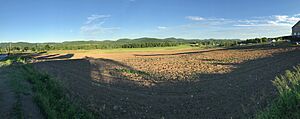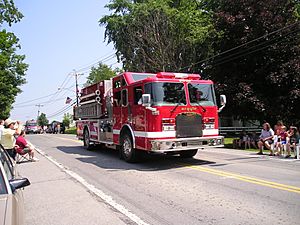Argyle, New York facts for kids
Quick facts for kids
Argyle
|
|
|---|---|

Location in Washington County and the state of New York.
|
|
| Country | United States |
| State | New York |
| County | Washington |
| Area | |
| • Total | 57.80 sq mi (149.69 km2) |
| • Land | 56.54 sq mi (146.43 km2) |
| • Water | 1.26 sq mi (3.26 km2) |
| Population
(2020)
|
|
| • Total | 3,644 |
| • Estimate
(2022)
|
3,648 |
| • Density | 65.46/sq mi (25.28/km2) |
| Time zone | UTC-5 (Eastern (EST)) |
| • Summer (DST) | UTC-4 (EDT) |
| ZIP code(s) |
12809
|
| Area code(s) | 518 838 |
| FIPS code | 36-115-02561 |
Argyle is a town in Washington County, New York, United States. It's part of the larger Glens Falls area. In 2020, about 3,644 people lived there. The town got its name from many early settlers who came from Argyllshire in Scotland.
Contents
A Look at Argyle's Past
Before Argyle became a town, its lands were hunting and fishing grounds. Native American tribes like the Mohicans and Mohawk used to live here. From 1628 to 1664, the Mohawk tribe had a special agreement for fur trading. They traded with the Dutch New Netherland Colony at Fort Orange, which is now Albany.
How Argyle Became a Town
The town of Argyle was officially formed on March 23, 1786. This happened during the 9th New York State Legislature. Many of the first settlers were from Argyll, Scotland. They chose to name their new home after their native land.
During the American Revolution, people in Argyle had mixed feelings. Some supported the British, while others joined the American fight for freedom. Records show that at least 95 men from Argyle joined the American militia. Local events, like the killings of Jane McCrae and the John Allen family in 1777, may have influenced many settlers.
Changes to Argyle's Borders
Over time, parts of Argyle were used to create new towns.
- In 1803, a southern part near Cossayuna Lake became the Town of Greenwich.
- In 1818, a northwestern part along the Hudson River became the Town of Fort Edward.
Argyle and the Fight for Freedom
In the past, some people in Argyle owned enslaved people. This was before slavery was completely ended in New York State on July 5, 1827. However, Argyle was also home to people who fought against slavery. The Ransom Stiles home and the County Poor House are believed to have been stops on the Underground Railroad. This was a secret network that helped enslaved people escape to Canada.
During the American Civil War, many Argyle men joined the fight. About 90 men joined the 123rd New York Volunteer Infantry. Another 37 men joined the 93rd New York Infantry Regiment. Soldiers from Argyle also served in other New York infantry and cavalry groups. Some even joined the 20th, 26th, and 31st New York Colored Infantry Regiments.
Recent Events in Argyle
For many years, Argyle was a "dry town," meaning alcohol could not be sold there. This changed on November 5, 2019. Voters decided to allow alcohol sales in the town and village.
On August 10, 2020, an EF1 tornado touched down near Goose Island. It caused some damage to homes and trees, but luckily, no one was hurt. This was the first confirmed tornado in Argyle since 1950.
Argyle was also close to the path of the Solar eclipse of April 8, 2024. On April 8, 2024, the town experienced a 98.5% solar eclipse. The peak of the eclipse was at 3:27 PM.
Argyle's Natural Surroundings
Argyle covers about 57.8 square miles. Most of this area is land, with about 1.1 square miles of water. The town is located along the northern part of the Taconic Mountains. It sits between the Hudson River and the border with Vermont.
Landscapes and Wildlife
In the western part of Argyle, you'll find farmlands and small wooded areas. These are part of the Hudson River valley. Some of these farmlands are in the Washington County Grasslands. This large area is important for many birds.
- It's a winter home for endangered short-eared owls.
- It's also a breeding ground for other grassland birds like Northern Harriers and Bobolinks.
- Snowy Owls often visit in winter.
The eastern part of Argyle has higher elevations. Several mountains here are over 1,000 feet tall. The highest point is over 1,120 feet, north of Goose Island.
Lakes and Views
Argyle has two main lakes:
- Summit Lake: A spring-fed lake.
- Cossayuna Lake: A larger lake located further east.
Both lakes have many seasonal camps and year-round homes.
From many spots in Argyle, you can see beautiful mountain ranges.
- To the north and west, you can see the Adirondack Mountains.
- To the east, you can see the Taconic and Green Mountains of Vermont.
Roads in Argyle
- NY Route 40 runs north and south through the town.
- NY Route 197 runs east and west, connecting to nearby Fort Edward.
Argyle's People
| Historical population | |||
|---|---|---|---|
| Census | Pop. | %± | |
| 1790 | 2,341 | — | |
| 1800 | 4,597 | 96.4% | |
| 1810 | 3,803 | −17.3% | |
| 1820 | 2,811 | −26.1% | |
| 1830 | 3,459 | 23.1% | |
| 1840 | 3,111 | −10.1% | |
| 1850 | 3,274 | 5.2% | |
| 1860 | 3,139 | −4.1% | |
| 1870 | 2,850 | −9.2% | |
| 1880 | 2,775 | −2.6% | |
| 1890 | 2,313 | −16.6% | |
| 1900 | 1,995 | −13.7% | |
| 1910 | 1,806 | −9.5% | |
| 1920 | 1,535 | −15.0% | |
| 1930 | 1,452 | −5.4% | |
| 1940 | 1,611 | 11.0% | |
| 1950 | 1,801 | 11.8% | |
| 1960 | 1,898 | 5.4% | |
| 1970 | 2,415 | 27.2% | |
| 1980 | 2,847 | 17.9% | |
| 1990 | 3,031 | 6.5% | |
| 2000 | 3,688 | 21.7% | |
| 2010 | 3,782 | 2.5% | |
| 2020 | 3,644 | −3.6% | |
| U.S. Decennial Census | |||
In 2020, Argyle had 3,644 people living in 1,422 households. The population density was about 65 people per square mile. Most residents (91.8%) were White. About 1.89% of the population identified as Hispanic or Latino.
Family Life in Argyle
- About 20.7% of households had children under 18.
- 50.9% of households were married couples.
- The average family size was 3.11 people.
Age and Education
- 20.7% of the population was under 18 years old.
- 22.2% were 65 years or older.
- The average age in Argyle was 47.2 years.
- About 18.4% of residents had a bachelor's degree or higher.
- About 5.6% of the population were veterans.
Income and Health
- The average income for a household in Argyle was $66,000.
- The average income for a family was $76,389.
- About 8.4% of the population lived below the poverty line.
- About 7.6% of the population did not have health insurance.
Argyle's Community and Fun Events
Argyle has many fun community events throughout the year!
- Memorial Day Parade: Led by the Argyle American Legion Post 1518.
- July 4th Parade and Chicken Barbeque: Hosted by the Argyle Fire-Rescue Department.
- Thanksgiving Holiday Meal: Provided by F.E.A.S.T. (friends ensuring a super thanksgiving).
- Hometown Holiday Celebration: A community event with a tree lighting in December.
- Book Fair: Held by the Argyle Free Library on July 4th.
- Carl Lufkin Memorial Pull for the Cure: A tractor and truck pull in July that raises money for cancer charities.
- Haunted House: Open on weekends in October at the Ransom Stiles house.
- Town-Wide Garage Sale: Held over the Columbus Day Holiday.
Scottish Heritage
On September 18, 2021, Argyle brought back a special tradition: Thistle Day! The thistle is the national flower of Scotland. This celebration honors Argyle's Scottish roots. It includes a parade, barbeques, craft markets, a concert, and fireworks. Since then, Thistle Day has continued every year, now with a bonfire and Scottish games!
Movie Location
In 1983, the former Camp Algonquin on Summit Lake was a main filming spot for the movie Sleepaway Camp.
Famous People from Argyle
Many interesting people have connections to Argyle:
- John Allen Family: A frontier family who lived in South Argyle. They were attacked in 1777 during the American Revolutionary War.
- Alexander Barkley: A New York State Republican Legislator in the 1860s. He also served as Canal Commissioner.
- Ebenezer Clark: Elected to the 1st New York State Legislature in 1777 and served many times after. He is buried in Argyle's Old Scots Cemetery.
- Evelyn Clark Colfax: Born in Argyle in 1823. She married Schuyler Colfax, who became the Speaker of the U.S. House of Representatives and later Vice President for Ulysses S. Grant.
- Edward Dodd: Moved to Argyle in 1835. He served in the U.S. House of Representatives from 1855 to 1859 and was an early member of the Republican Party.
- Eliakim Doolittle (1772–1850): A composer.
- Julia Spencer-Fleming: An author of mystery novels. She lived and went to school in Argyle in the 1970s.
- John Alexander McGeoch: A psychologist and educator born in Argyle in 1897. He studied human learning and memory.
- Grandma Moses: A famous American folk artist who worked in Argyle for a time.
- Solomon Northup: An abolitionist who was kidnapped and sold into slavery. He wrote the book "12 Years A Slave" and lived in Argyle briefly.
- Robert S. Robertson: A U.S. Congressional Medal of Honor recipient from the Civil War. He was born and raised in North Argyle and later became Lieutenant Governor of Indiana.
- Robert B. Scott: Another U.S. Congressional Medal of Honor recipient. He is buried in Argyle's Prospect Hill Cemetery.
- David Sheridan: An inventor and generous person who created medical catheter plants in North Argyle, providing many jobs.
Places in the Town of Argyle
Communities
- Argyle: This is a village located inside the larger town of Argyle. You can find it on NY-40 and NY-197.
- Durkeeetown: A place along the western edge of the town, near Fort Edward.
- Goose Island: A small community east-northeast of Argyle village.
- Lick Springs: A location west of South Argyle.
- North Argyle: A community northeast of Argyle village on NY-40.
- South Argyle: A community south of Argyle village on NY-40.
- The Hook: An area where there used to be hotels for travelers.
Natural Spots
- Argyle Airport (1C3): A small grass airstrip northeast of Argyle village.
- Barkley Mountain: A hill east of Argyle village (627 feet high).
- Cossayuna Lake: The biggest lake in the town, located in the southeastern part (422 feet elevation).
- Dead Creek: A stream that flows out of Argyle on the western side.
- Moses Kill: A stream that goes through North Argyle and Argyle village. It eventually flows into the Hudson River.
- Mud Pond: A small lake north of Goose Island.
- Murdock Mountain: A hill north of Summit Lake (1,014 feet high).
- Summit Lake: A lake west of Cossayuna Lake.
- Tamarack Swamp: A swamp near the northern town line.
- Todd Mountain: A hill northwest of Goose Island (1,038 feet high).
- Wood Creek: A stream that flows out of Argyle near the northwestern corner and goes north to the Champlain Canal.
See also
 In Spanish: Argyle (Nueva York) para niños
In Spanish: Argyle (Nueva York) para niños




